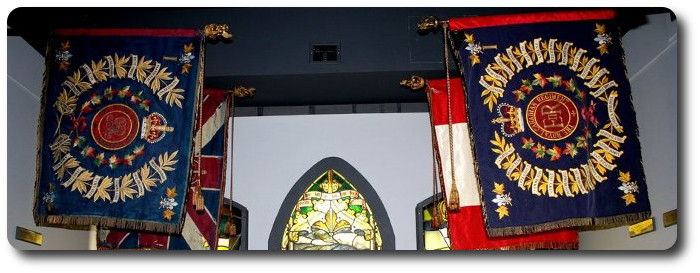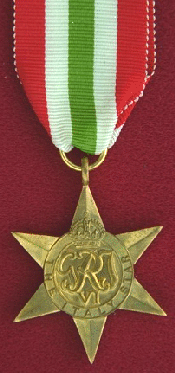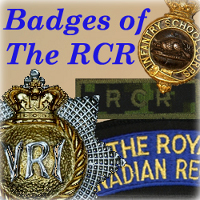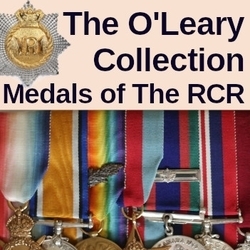
Researching The Royal Canadian Regiment
The Assault on the Beaches of Pachino, Sicily; July 1943
By Maj, R. G. Liddell, reproduced from The Connecting File, April, 1946
Major R. G. Liddell re-joined the Regiment as a Subaltern reinforcement officer in March 1942 and saw continuous service with the Battalion from then until September 1944. First as Platoon Commander then 2IC of a Company and was Commanding "A" Company when the assault on Pachino took place.

The Italy Star was awarded for one day operational service in Sicily or Italy between 11 June 1943 and 08 May 1945.
On the 1st July 1943 units of the 1st Cdn Div wore informed that they were to take part in an assault landing on the Pachino Peninsula of Southern Sicily. Until this information was given out, conjecture as to destination had ranged from Norway to Burma, the only thing that seemed certain was that this was NOT just another exercise.
After troops had been put into the general picture by Coy Commanders (who had just previously received this information from the O.C.), maps and the Battalion Operational Orders were distributed to Coy Commanders, who then had 48 hours to study Battalion Orders and prepare Coy plans. These plans were then discussed in detail at a Battalion conference so that all Coys were fully in the picture as to the intention and method of every sub-unit.
The Battalion plan generally was to land on a two Coy front, "D" right and "C" left. These Coys would establish a bridgehead and liaise to the flanks) "D" to 51 H.D. who were landing on our right and "C" to H. & p. E. who were left assault Battalion of 1st Canadian Infantry Brigade. "A" Coy would then land on the right beach and push inland to a large building suspected of being of sizeable military importance. When this building had been subdued "B" Coy was to pass through and knock out a coast battery to the north. The Battalion would then occupy a ridge to the north overlooking the Pachino Air Field. "B" and "D" would then cross the Air Field and seize cross roads on the east side of the landing strip. "A" and "C" would then pass through to occupy high ground to the east of the Air Field. "A" Coy in an area of some huts noted on the defence overlay as "Military Activity" and "C" Coy in the vicinity of a water tower. "B" and "D" would then move up and the Battalion would firm up thereby completing the task set for the Battalion for "D" Day.
This plan didn't present any difficulty as it was already thoroughly familiar to all ranks who had gone through all the necessary motions twice in Scotland before sailing. All that now remained to be done was plan the actual details on section level insofar as individual houses, etc., were concerned. Excellent air photos made this task fairly easy.
Exhaustive briefing sessions were indulged in by platoons until every individual in the Battalion knew exactly what was expected of him at any time and in any conceivable situation as well as in several highly inconceivable ones.
Our trip through the Mediterranean to Malta had an air of indescribable unreality. The weather was perfect and no enemy planes put in an appearance. The heat was very similar to Ontario in July and something we hadn't experienced since leaving home. The coast of Africa was frequently close enough for buildings on shore to be very plainly seen but it was so herd to realize that it was really Africa and we were so far from home and in such an unfriendly part of the world.
A lot of the time was spent cleaning and examining ammunition and weapons with positively fanatical care. Every one became somewhat thoughtful and a bit quieter than usual. A lot of writing home was done and attendance at communion became practically one hundred percent.
It is doubted that any other force of its size ever went into its first battle with quite the same attitude. No feeling of bravado or over-confidence could be sensed but one gained an impression of supreme confidence in the ability of every part of the force to do its job on schedule, no matter what the opposition amounted to.
On the 9th July (D-l) the sea began to get rough and the sally ports were under a ton or so of water most of the time.
Off Malta we joined convoys from the U.S. and Africa, ships stretched as far as one could see in two directions. The rough sea and the number of ships in sight made everyone think of the Spanish Armada, not a very happy thought but one that persisted.
The evening meal was a rather thoughtful one, jokes were a bit on the corny side and although the rough weather was carefully avoided as a subject of conversation it was very present in everyone's thoughts, as the idea of going through that sort of sea in an L.C.A. wasn't exactly soothing.
In the evening all the Officers gathered in the Officers' Lounge where a short prayer for the success and safety of the force and our loved ones was offered by the Battalion Padre. We all wished each other luck, had another look at the weather (which hadn't improved) and I went below to see how the troops were and to dress for going ashore.
The time to man craft arrived with amazing suddenness. When one's serial was ordered to boat station the blower had a very final sort of sound and the ship suddenly seemed an awfully safe and comfortable sort of place to be in.
"C" Coy was to land in DUKWS as a bar had been found on their beach that prevented L.C.A's from running in. Word of this bar had reached us after sailing, so DUKWS were sent from Africa in L.C.T's and were meeting us at the dropping point. This necessitated L.C.T's coming alongside while "G" Coy loaded from sally ports into the L.C.T's and then into DUKWS.
By a seeming miracle the sea had subsided when we reached the dropping point and although the movement of an L.C.A. was nauseating it wasn't dangerous.
"A" Coy could not be lowered when craft were manned owing to the L.C.T's being immediately below taking on troops. The wait to drop became longer and longer and it was found that even excitement and possibly the last few moments of life can become boring if overdone. Anyway "A" Coy had a fairly sound snooze while "E" Coy was unlucky enough to be water-borne and taking a bit of a beating from the still fairly active sea.
Finally, however, the L.C.T. sheered off and our big moment had arrived. After months of boat training in absolute silence for just this event, we were lowered amid a terrific clatter of winches and screeching blocks while the staff-Captain of the ship wished us luck, good shooting and an early trip home (preferably on his ship) in a voice developed in the Dutch fishing fleet on the North Sea which must be a very noisy place. All this noise seemed in very poor taste to me personally, as I was convinced that every soldier in Sicily would now have taken first pressure and be just waiting for my appearance.
Apparently however, all this commotion failed to carry the seven miles to shore as it was some time before anyone began to take any apparent notice of us, by that time it was daylight anyway and we were about two miles off the beach.
Daylight presented a weird spectacle, the horizon of sea and sky could literally NOT be seen for ships of all sizes and shapes, (all with their balloons well up). Level with us were strings of L.C.A's wallowing along in line a head with the monitor H.M.S. ROBERTS sitting in the middle of all the small stuff having a few shots at something well inland.
About this time the shore batteries tried to do something about it but didn't seem to come very close to anything at least I didn't hear of any craft or ships being hit. The whole show had a sort of lavish scheme air and seemed less dangerous than some of the training we'd done in England; in fact it seemed hard to convince oneself that it was the serious stuff at last.
Eventually of course the boat ride ended and we hit bottom, baling out into knee-deep Mediterranean amid the abject apologies of the Navy Coxwain for not getting us in dry and our own heart-felt thanks to him and his gang for getting us back to our own element at all.
It still amazes me that we should leave Scotland and sail several hundred miles, finally decide to go up a narrow dirt road that ended on the west coast of Sicily and eventually walk straight out of an L.C.A. and directly up that very road.
The enemy didn't put on a show while we came ashore so we started up the road toward our first task --- the subduing of Machini. At this stage we wore moving by bounds, keeping a leg on the ground and very enemy conscious. The occasional shot was heard from our right, presumably from 51 H. D., investigation however proved it to be a Platoon of H & P E who hadn't had as good a navigator as we had and were landed about two miles south of where they should have been, They had been passing the time by shooting at the crew of en Italian M.G. who wore supposed to be filling the beach with corpses but were actually trying either to get back to the gun they had hurriedly left or else get close enough to surrender. We left them both at it and got back .to the job of subduing Machini which turned out to be a huge building alright, a lot dirtier than the air photos indicated and garrisoned by a toothless old woman (very dirty) and three small kids (also dirty). The odd rifle and set of pouches indicated the hurried departure of Italian Troops, so B Coy pushed on to take out their battery while A Coy stood grimly by waiting to shed their life's blood trying to blow a way through the wire if B Coy should find their job a bit too large and call for help. It seems however that the wire surrounding the battery was only a foot h1gh and apparently not mined, as B Coy wandered in without any trouble. Ono Italian foolishly exposed himself and had his jaw shot off. This sort of treatment looked so grim to the rest of the battery that they immediately surrendered.
The Battalion now moved toward the high ground a mile to the north which overlooked Pachino Airfield. The occasional rifle shot came our way but there were no casualties and no would-be snipers were found, Difficulty was experienced in keeping orientated as the roads shown on the map (which looked like well paved highways on the air photos), were actually mere tracks with about three inches of powdery dust and it was hard to reconcile expectations with the grim reality.
On reaching our next position the view of the long awaited airfield was rather disappointing, the runways had been ploughed up three days previously and the whole presented a rather drab contrast to the mental picture we had already formed.
Contact was made with D Coy H & P E whose commander requested that we stop shooting at his lads whenever they moved forward. As we hadn't been shooting at all the logical conclusion was arrived at, the local enemy must be getting active. "A" Coy then provided covering fire while "D" Coy, H & P E crossed the open spaces and on toward their next objective. What we took at the time to be mortar bombs commenced arriving --- they had a very loud bang, a lot of black smoke but didn't seem to be doing any damage.
At this time orders came from the C.O. for "A" and "C" Coys to move to their final objectives, the planned crossing of the airfield by "B" and "D" being scrapped as unnecessary and a needless use of time.
The approach to the airfield was down a forward slope, enemy MG's and rifles really got busy but casualties were amazingly light. Getting on the airfield was a bit, of a mental hazard as the wire here was serviceable and it was necessary to crawl under it looking for mines, holding up the wire so it wouldn't catch on equipment, etc., and hope that whoever was doing the shooting wouldn't suddenly improve and get a hit. Once on the field proper the snipers were dealt with and "A" and "C" Coys crossed in open order. The small arms and supposed mortar fire was still present but not accurate and anyway there wasn't any cover available to use.
On nearing the area marked on the map as "enemy activity" the volume of enemy fire greatly increased. We found some wooden barrack huts with beds nicely made up and the whole place cleaned and tidied up but qui eo empty, It was impossible to locate exactly where the enemy fire was coming from and our 3" mortars could not be called on as the Coy was out of radio range of Tactical Headquarters. We therefore commenced crawling forward through a vineyard toward a very well camouflaged house. One section found a gap in the wire and lead by the #1 Bren (the Section Commander had been wounded) dashed into 'that turned out to be a battery position and immediately commenced getting rough with the local inhabitants. This Section knocked out two MG's in concrete emplacements and neutralized that immediate area. The remainder of the Coy surged through the gap and the Italian Commander decided he'd had it and surrendered.
Enemy troops commenced appearing from holes in the ground and from around corners till the total became alarming ---the total of 253 assorted ranks were finally collected and started back to the beach while the Coy feverishly prepared to beat off a terrific counter-attack which we felt sure would come at any moment.
The C.O. came up at this point and seemed very pleased to see a tame 4 gun howitzer battery and a truck load of LMG' s lying around. He said "D" Coy was streaming up to make our left flank secure and carriers were going ahead to have a look around.
As soon as the C.O, left, someone started sniping our position and figures wore seen about 1000 yards to the east. Bren fire caused said figures to disappear and an attempt was made to turn one of our captured guns around to bring fire down on the expected "Forming-Up Place" of the expected counter-attack. A tractor would have been necessary however, as the guns were dug in at the bottom of an incline and the attempt had to be abandoned.
After about 20 minutes of somewhat futile shooting on both sides a Liaison Officer from the Devonshire Regiment arrived via Pachino with the information that they had landed on the east coast and were working toward us but meeting Some opposition. It appeared that we had some sort of an enemy group between us so a plan was being made for a beautiful squeeze play when to our mutual horror it was discovered that we'd been shooting at each other for the past half hour. Luckily no one had been hurt so we called it off before any damage was done.
In the meantime "D" Coy had pushed on to the north east and ran into some rather determined enemy who were pinned down by "D" Coy and finally taken care of by tanks which had landed and come up to get into the alleged battle. The enemy apparently had decided to leave us along so we began to settle down a bit. Now that the fighting was over for the moment, we became conscious of being literally exhausted. Having worn small packs and our full load of SAA since 0100 hrs that morning and having been under somewhat of a nervous strain for a rather longer time it was not surprising.
Tactical Headquarters decided to spend that night in the Coy area so platoons had to be moved out to cover a greater area, this caused a break in inter-platoon communication and didn't improve our peace of mind. It was decided that if we were attacked we would use enemy weapons and ammunition as long as possible in order to conserve our own, consequently a Breda LMG and large stack of ammunition were placed beside each Bren and each rifleman had four or five fully loaded Italian rifles to use before his own weapon.
Just after dark a Battalion Operational Group was held and nicely under way when an air raid was launched on the shipping which was now ~assed on both sides of the peninsula. The AA fire was unbelievably intense and no doubt the colours were very pretty although our appreciation of it was somewhat marred by the likelihood of nose caps, etc., falling in our vicinity.
The air raid finally stopped and peace and quiet reigned again until a picquet placed by another Coy on our front failed to answer a challenge clearly or fast enough so was fired on from one of our section posts. Unfortunately, he fired back so all our guns commenced firing on fixed lines and every one stood to, In our tired and tense state, bushes and shadows seemed to move so firing was fairly general for about five minutes, when all calmed down again.
In the morning captured weapons and equipment were piled near the road ready for the salvage people and the area was tidied up generally. As it was an Italian Regimental Headquarters, the place was fairly bursting with booty but as anything taken had to be carried in pocket or pack, we didn't get much out of it.
Shortly after noon we were again on the move north to Rossolini and the scene of our first fight was left to rehabilitate itself into a wheat field or vineyard again.
This is NOT by any means a full account of the action of The Royal Canadian Regiment at Pachino, it is not even a full account of the part played by "A"Coy in that particular battle but rather a jumble of some of the things seen and experienced by the writer who was at the time a member of "A" Coy.
Due to the relevant map and war diary being unavailable at this late date it is rather hard to accurately recall all that happened) names of persons have been avoided as it is felt unfair to mention some of the participants and not others as the omissions would be entirely due to bad memory.
If the impression is given that Pachino was a one Coy show it is regretted and apologized for as such is not the intention. - R.G. Liddell


